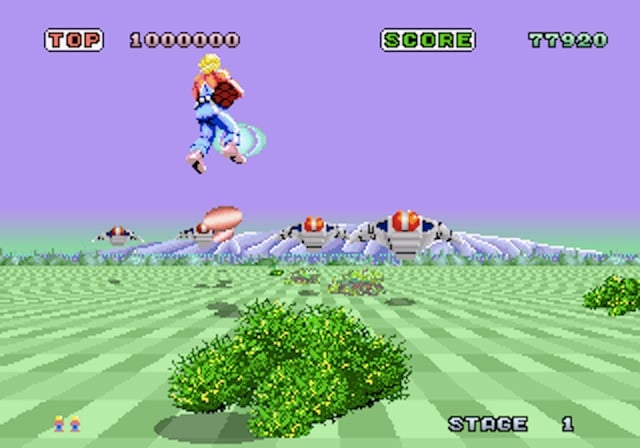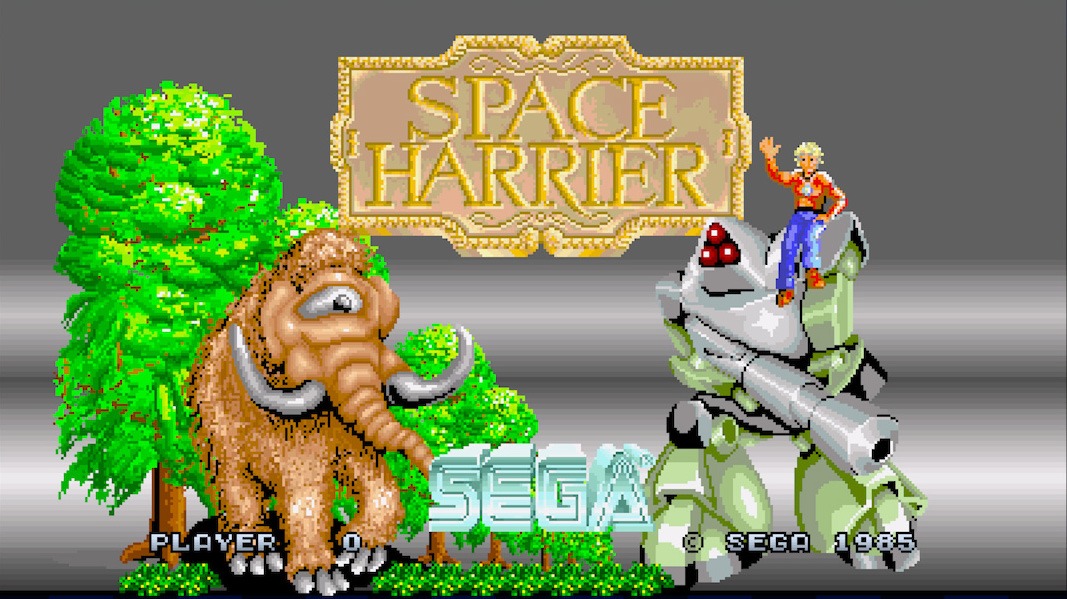Space Harrier
Released in 1985 by Sega, “Space Harrier” stands as a landmark in the world of arcade games. Designed by Yu Suzuki, it’s not only a testament to the innovation of its time but also a continuing influence on the shoot ’em up genre. This article explores the game’s development, gameplay, impact, and lasting legacy in the arcade industry.
A Visionary Creation
“Space Harrier” was developed during a time when the arcade industry was burgeoning with technological advancements. Suzuki, who later became famous for the “Virtua Fighter” and “Shenmue” series, wanted to create a fast-paced, immersive game. Utilizing cutting-edge technology of the 1980s, the game featured pseudo-3D graphics through Sega’s “Super Scaler” technology, which allowed rapid scaling of sprites, creating a dynamic and fast-moving gaming experience.
The game’s development was a challenging process, primarily due to hardware limitations. Suzuki and his team had to develop custom hardware and software solutions to bring their vision of a high-speed, fantasy shooter to life. The result was a game that felt faster and more fluid than anything else available at the time.
Gameplay Mechanics
“Space Harrier” is characterized by its third-person rail shooter style, where players control the protagonist, who is equipped with a jet-propelled firearm. The character flies across various landscapes and battles a plethora of enemies and bosses that appear both in the air and on the ground. The control setup was intuitive yet revolutionary, featuring a large, analog flight stick that responded to the player’s movements, adding to the game’s immersive feel.
/cdn.vox-cdn.com/uploads/chorus_image/image/3713817/space_harrier_arcade_960.0.jpg)
The game’s levels, known as “stages,” are set in the “Fantasy Zone,” a vibrant and surreal landscape. Each stage introduces new enemies and environmental challenges, requiring players to continuously adapt their strategies.
Cultural and Commercial Impact
Upon its release, “Space Harrier” quickly became a favorite among arcade-goers, captivating players with its high-speed action and vibrant, colorful graphics. It was one of the first arcade games to deliver a true sense of speed and three-dimensional movement, influencing many subsequent video games.
Commercially, the game was a significant success for Sega, helping to establish the company as a leading name in the arcade industry. It also spawned several sequels and adaptations across various platforms, from home consoles to handheld devices, ensuring its presence in the gaming community’s consciousness.

Platform Expansion and Legacy
Originally launched in arcades, “Space Harrier” was later adapted for a variety of home gaming systems, broadening its reach and influence. It appeared on:
- Sega Master System: This version was one of the most well-received adaptations, praised for its faithful recreation of the arcade’s graphics and gameplay.
- Commodore 64 and Amiga: While these versions differed slightly in terms of graphic fidelity and sound quality due to hardware limitations, they still managed to capture the essence of the arcade experience.
- Nintendo Entertainment System (NES): A version developed by Takara was also released, though it featured modifications due to the console’s hardware constraints.
- Game Gear and Sega Saturn: These later versions included improved graphics and, in the case of the Sega Saturn, included as part of “Sega Ages: Space Harrier,” which aimed to deliver a more authentic arcade experience.
- PlayStation 2 and Nintendo 3DS: These platforms saw releases under the “Sega Ages” and “3D Classics” series, respectively, with the 3DS version featuring enhanced 3D graphics that paid homage to the original’s 3D aspirations.
“Space Harrier’s” adaptation across these platforms helped cement its legacy as a classic, demonstrating the game’s flexibility and enduring appeal. Its influence is still seen in modern gaming, particularly in genres that prioritize speed and immersive, fantastical environments.
Legacy and Influence

The influence of “Space Harrier” extends beyond its immediate commercial success. It helped set the stage for future advancements in gaming technology, particularly in the realm of 3D graphics and immersive gameplay. The game’s use of an analog control system paved the way for more sophisticated controls in later video games.
Moreover, “Space Harrier” remains a beloved classic, celebrated for its bold, imaginative design and its role in shaping the shoot ’em up genre. It continues to be featured in retro game collections and is frequently cited by game developers as a source of inspiration.
“Space Harrier” set a benchmark for fast-paced, pseudo-3D arcade shooters, influencing many subsequent games. If you’re interested in exploring games that share a similar spirit or gameplay mechanics, here are several titles that either drew inspiration from “Space Harrier” or contributed uniquely to the genre:
- After Burner (1987) – Another Sega classic, “After Burner” puts players in the cockpit of a fighter jet, featuring similar fast-paced, on-rails shooting mechanics and the use of Sega’s “Super Scaler” technology to create an immersive 3D experience.
- Galaxy Force II (1988) – Also developed by Sega, this game expanded on the pseudo-3D shooting concept, offering more complex graphics and deeper gameplay mechanics. It’s renowned for its elaborate arcade cabinets, which included a moving seat to simulate flight.
- Star Fox (1993) – Released on the Super Nintendo Entertainment System, “Star Fox” utilized the Super FX chip to render its 3D graphics, bringing a new level of depth to console gaming. It featured a spacecraft navigating through various environments, similar to “Space Harrier.”
- Rez (2001) – While not a direct descendant of “Space Harrier,” “Rez” is an on-rails shooter that combines music and visuals in an evocative, abstract experience. Its immersive sensory blend and gameplay echo the trail blazed by earlier Sega titles.
- Panzer Dragoon (1995) – Available on the Sega Saturn, this game offers a unique take on the on-rails shooter format, featuring a fantastical setting and storyline. Players ride a dragon and engage in aerial combat, reminiscent of the high-speed action in “Space Harrier.”
- Sin and Punishment (2000) – Developed by Treasure for the Nintendo 64, this game is a cult classic that combines shooting and dodging mechanics with a third-person perspective, offering a unique and challenging gameplay experience.
- Burning Force (1989) – This Namco title is often seen as a spiritual successor to “Space Harrier,” with players controlling a female protagonist who navigates through different stages on a futuristic bike, shooting enemies in a 3D-like environment.
- Space Harrier 3D (1988) – A sequel to the original that was released on the Sega Master System, employing special glasses to create a 3D effect, enhancing the pseudo-3D gameplay of its predecessor.
Space Harrier
“Space Harrier” not only defined the shoot ’em up genre but also demonstrated the potential of arcade gaming technology. Its legacy is evident in the way modern games continue to push the boundaries of speed, immersion, and graphical capabilities. For many, “Space Harrier” is more than just a game; it’s a nostalgic piece of arcade history that continues to capture the imaginations of players around the world.

